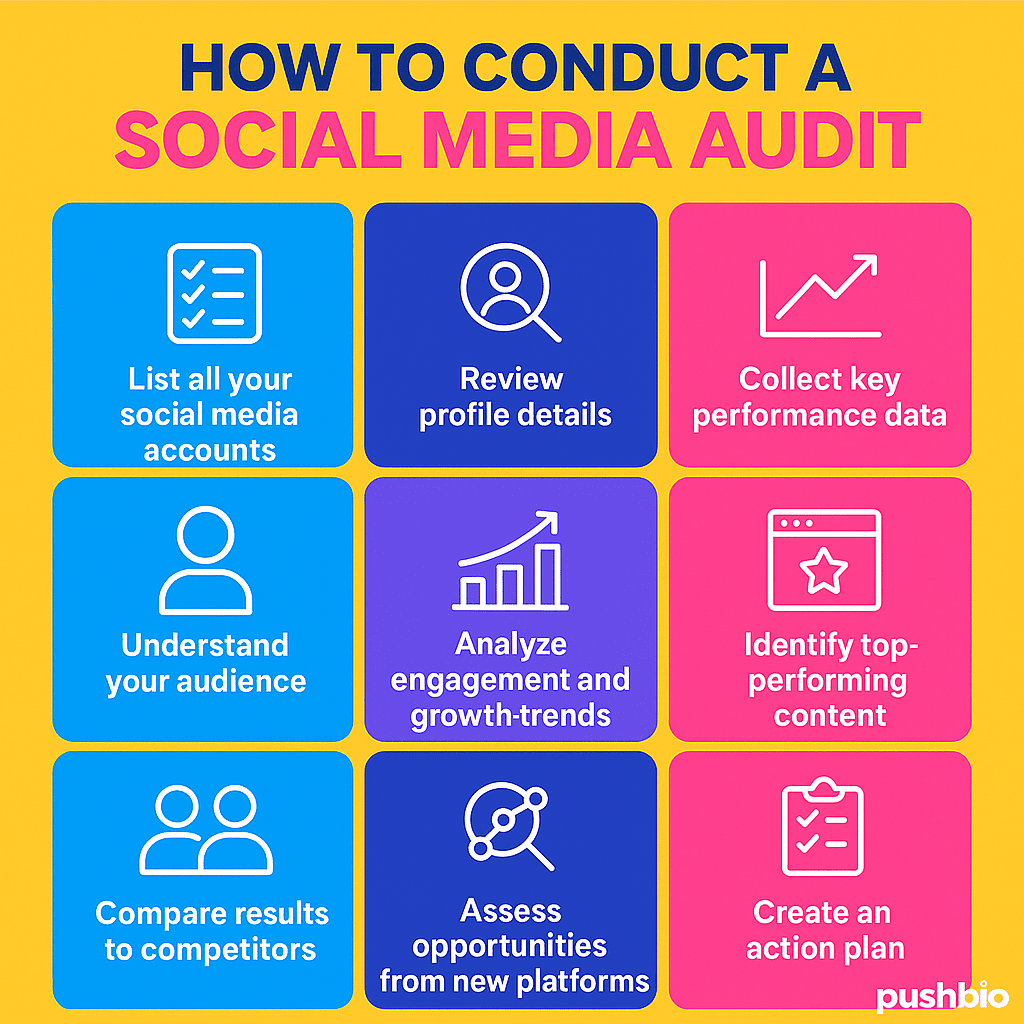Social media plays a major role in business growth. Brands connect with customers, promote their products, and build trust all through platforms like Instagram, Facebook, TikTok, and LinkedIn. But with all the excitement of going viral or gaining new followers, it’s easy to get caught up in the social media buzz and lose track of what truly drives results.
A few popular posts might make your brand look successful, but are they really helping you reach your goals? To really answer this question, creators must understand what social media audit is. In simple terms, social media audit is a “check-up” for your online presence. It helps you see what’s working, what’s not, and where you can improve.
To help creators and brands understand this concept, we have come up with a guide showing the simple steps on how to conduct a social media audit, and the benefits it brings to your business. It’s the first step toward building a smarter, more effective online strategy.
A social media audit is a detailed review of all your social media accounts to understand how well they are performing. With this step, creators, brands and businesses take a closer look at their online activities to see what’s working, what’s not, and where they can make improvements.
Social media audit involves checking your posts, engagement levels, audience growth, and overall content strategy to ensure everything aligns with your business goals. It is a holistic performance review that helps you stay organized and focused. During your social media evaluation, you gather data from each platform such as likes, comments, shares, and follower trends to identify your strongest and weakest areas.
Studying this information lets you create an audit report that highlights your performance and guides you toward better decisions. Ultimately, a social media audit helps you use your platforms more effectively to boost engagement and achieve real business results.
A successful social media audit starts with knowing exactly what to review and measure. Each part of your audit helps you understand how your social profiles perform and where improvements are needed.
Therefore to successfully perform an audit, you need to understand the key components to look at in your performance review. These include:
1. Profile information
Your profiles are the first impression people see. During an audit, check that each account is fully filled out with details like bio, profile image, cover image, contact links, and description. Also, check for branding and ensure branding (logo, colors, tone) is consistent across platforms so people instantly recognize your brand. For serious brands, using a unified handle or username if possible gives you a better chance at recognition from your audience.
2. Publishing frequency and content calendar
Posting too often can overwhelm followers; posting too little can make you disappear. A smart audit reviews how often you publish and whether you stick to a plan. This helps avoid random posting or long silences (ghosting).
- Gather your posting history for each platform (past 3–6 months).
- Note days and times you publish.
- Spot gaps, clusters, or days with no posts.
- Compare this to industry best practices or competitor schedules.
A consistent calendar helps maintain audience interest and signals reliability. In your social media audit, tracking publishing cadence is a key auditing metric.
3. Content performance
Not all content is equal. During your audit, you’ll analyze which posts attract more likes, comments, shares, saves, or clicks. This tells you what resonates. Use native social media analytics or third-party tools.
Action Steps:
- Rank your posts by engagement (top vs bottom).
- Categorize content types (e.g. video, image, text, carousel).
- Note themes or topics that perform better.
- See if timing or format correlates with better results.
From this, your audit report reveals which content to double down on and which to drop.
4. Referral traffic and conversions
Your social media efforts should lead people to take action, ideally visiting your website and converting (purchase, sign-up, download). In the audit, measure how much of your website traffic comes from social platforms and how many of those visits convert.
Action Steps:
- Use tools like Google Analytics to trace referral traffic from social channels.
- Check pages visited and how users flow through the site.
- Track conversion rates (e.g. how many social visitors ended up buying or subscribing).
- Attribute campaigns or posts that drove most conversions.
This shows you whether your social media is just for show or actually fueling real business goals.
5. Audience insights
It’s important to know who is paying attention and not just how much attention. Audit the demographics, locations, interests, and behaviors of your followers and engagers. This insight helps you tailor content and messages to match who’s actually listening.
6. Engagement metrics
These are classic auditing metrics as they tell you how lively your audience is with your content. Reach indicates how many people saw a post, while likes/comments/shares show how actively they interacted.
Action Steps:
- For a given period (e.g. last 3 months), tabulate metrics per post: reach, impressions, likes, comments, shares, saves.
- Compute engagement rate (interactions ÷ reach or followers).
- Spot content that has high reach but low engagement.
- Track trends to see whether engagement is rising or falling over time.
High engagement indicates your content resonates; low engagement suggests strategy needs a tweak.
7. Competitor benchmarking
It’s not enough to know your numbers. You must compare them with competitors in your niche. This helps you spot gaps and opportunities.
Action Steps:
- Identify 3–5 competitors or similar brands.
- Record their follower size, posting frequency, engagement rates, top content.
- Compare their content themes, visual style, tone, and campaigns.
- Note where they outperform you (which platforms, content types, posting times).
With this, your social media audit becomes strategic as you don’t just audit yourself but you learn from what others are doing well.
Running a social media audit may sound complex, but it’s actually a structured process that helps you understand your online performance. It’s the foundation of any strong digital strategy because it shows where new opportunities lie.

To help you out, we’ve compiled a social media audit guide to show the key steps to review, measure, and optimize your social platforms using clear data and actionable insights:
1. List all your social media accounts
Start by creating a master list (e.g., spreadsheet) of every social profile your business owns both active or inactive. Include platform name, URL, username or handle, and whether it’s still in use or abandoned. This ensures you don’t miss any hidden or forgotten profiles.
Many audit templates begin with this step to establish full coverage. When done correctly, this gives you full visibility of your social media footprint and helps you decide which accounts to keep, delete, or rebrand.
2. Review profile details
Now, dive into each profile’s settings and visual identity. Check bio, profile image, cover images, links, handle/names, brand tone, and contact info. Every profile should reflect your brand style and messaging clearly.
You’ll spot issues like outdated logos, wrong URLs, inconsistent brand voice or mismatched naming.
Action steps:
- Check each element (bio, images, links) for accuracy and branding alignment.
- Update missing or outdated profile fields.
- Make sure your profile includes a clear call to action (e.g. “Visit my site,” “Contact us,” “Shop now”).
This step is essential because without correct profile info, even great content may fail to convert or confuse your audience. Fixing these improves credibility and helps users recognize you across platforms.
3. Collect key performance data
Once you have all your accounts listed, gather metrics for each one over a recent time period (e.g. last 3–6 months). Use native platform dashboards or social media audit tools to pull data like follower growth, reach, impressions, engagement, clicks, and conversions.
Action steps:
- Export analytics reports (CSV, PDF) per platform
- Put data into your master audit spreadsheet
- Standardize metrics across platforms (so you can compare)
Accurate performance data is the backbone of a reliable audit report. Without it, your insights will be guesses.
4. Understand your audience on each platform
Next, dig into who your followers and engagers are. Look at demographics (age, gender, location), interests, behavior, and times they are active. Use features in native analytics or your chosen tools.
Action Steps:
- Pull demographic data (age, gender, location) from platform analytics.
- Compare your audience profile to your target persona.
- See which audience segments interact most.
- Note shifts in audience over time (new markets, decline in some segments).
This step helps you see if you’re reaching your ideal customer. If your actual audience is very different from your target persona, you know content, targeting, and strategy must adjust.
5. Use your goals to analyze engagement and growth trends
Here’s where you align performance with your goals. For each channel, evaluate how it’s doing relative to the objectives you set for it. This can be to either increase brand awareness, generate leads, grow followers, or drive traffic.
Action steps:
- For each platform, compute growth (followers over time)
- Track engagement rate trends (e.g. likes + comments + shares ÷ reach or followers)
- Compare performance across months or quarters
- See which goals each platform is helping you meet
With this, you’ll see which platforms or tactics are working toward your goals and which ones are underperforming.
6. Identify top-performing content
Use your collected metrics to find which posts gave the best results (high engagement, shares, clicks, conversions). Each social media platform’s analytics has tools to filter for top posts.
Action steps:
- Sort content by engagement or conversions
- Mark content themes, formats, or styles that succeeded
- Note timing and post types (image, video, carousel, story, live)
Knowing your best content gives you a blueprint for producing more posts that your audience loves.
7. Compare results to competitors
Benchmarking is essential to see where you stand. Choose 2–5 competitors or similar brands and review data you can access publicly: follower count, posting frequency, engagement, content style. Tools can sometimes help pull competitive insights too.
This step reveals opportunities (e.g. formats they use that you don’t) and gaps you need to close. It also helps you set realistic goals based on the industry.
8. Assess opportunities from new social platforms
Look beyond your current platforms and spot where the audience is migrating or trending. Consider testing newer or niche networks like Threads if they align with your brand and goals.
This part of your social media audit shows you growth paths you might be missing. However, you must be cautious in adoption as it’s always best to test before committing resources.
9. Create an action plan
The audit ends with meaningful steps forward. Use the insights gained to outline tweaks, tests, and changes. Prioritize based on impact and effort.
Action steps:
- List major issues which can range from low engagement to branding mismatch.
- Set S.M.A.R.T goals such as increasing engagement by 10% in 3 months.
- Assign tasks with deadlines and owners.
- Define metrics to track progress.
- Plan follow-up audits to measure if changes worked.
A solid action plan turns the audit from a report into real improvements in your social media strategy.
1. Identify strengths and weaknesses early
A well-conducted audit shows what parts of your social media strategy are working (your strengths) and where you are losing ground (your weaknesses). By reviewing engagement metrics, content performance, and audience behavior, you can see which posts or platforms outperform others. This helps you fix weak points before they become bigger problems and focus on content or platforms that bring real results.
2. Improve brand consistency across platforms
When you use a social media audit, you check that your branding such as logo, tone, bio, visuals is uniform across all your accounts. Consistency builds trust: if someone sees your profile on Instagram, then on Facebook or Twitter, they should recognize it as you. A consistent brand image helps customers remember you and see you as professional.
3. Enhance audience engagement
Regular audits help you understand which content types, topics, or posting times attract real interaction like comments, shares, and reactions. When you know what your audience responds to, you can tailor posts to spark more interest and build stronger relationships. Higher engagement often leads to more loyalty, better reach, and sometimes more sales.
4. Optimize content strategy
A detailed review of your past posts lets you see what content formats (video, images, carousels) or topics produce the best outcomes. With this, you can plan future content more efficiently focusing on what works. Doing this through insights from your social media audit or native analytics will save time, reduce waste, and improve your return on effort.
5. Maximize ROI
By using Social Media Audit Tools and reviewing performance data, you can determine which campaigns or posts are giving value and which ones cost you more than they return. This means you can shift budget, effort, and resources toward high-impact platforms and content. Better ROI comes when you stop spending time or money on what doesn’t work.
6. Gain competitive insights
A good audit doesn’t only look at your own numbers, it also involves comparing your results with competitors. Seeing what others in your niche are doing well (or poorly) can offer ideas, help you spot gaps in their strategies, or avoid their mistakes. This competitive benchmarking helps you position your brand more smartly.
7. Discover new opportunities
Social media is always changing with new platforms, new formats, shifting algorithms, and evolving audience preferences. Regular audits help you spot emerging trends or untapped channels early. These opportunities could be new features on existing platforms, growing audiences in unexpected places, or content styles that are gaining popularity. Acting on these insights gives you an edge.
A good rule of thumb is to conduct an audit of your social media profiles at least quarterly or twice a year. This frequency helps you stay on top of changes in your performance, audience behavior, and platform algorithms. Regular audits ensure your strategy stays fresh, relevant, and aligned with your business goals.
It’s also smart to schedule audits around key marketing periods like before or after major campaigns, seasonal promotions, or new product launches. This allows you to measure campaign success and make improvements before the next one.
FAQ
1. What is the main purpose of a social media audit?
The main purpose is to evaluate how your social media platforms perform against your goals. It helps you identify what’s effective, what needs improvement, and where you can focus your efforts for better results.
2. How long does a social media audit take?
The time depends on the number of platforms and the depth of analysis. A basic audit may take a few hours, while a detailed one with competitor benchmarking could take several days.
3. What tools are best for beginners?
If you’re just starting, try free or user-friendly options like Pushbio, Google Analytics, and Metricool. These are among the best social media audit tools for beginners because they offer clear insights without technical complexity.
In the end
A social media audit is a roadmap for growth. It helps you see clearly what’s working, what’s falling short, and how to create a stronger, more consistent online presence. Also, serious brands should regularly review their profiles, audience insights, and engagement data, so they can make smarter marketing decisions that lead to real business impact.
Thankfully, there are free analytics tools to use before building up to more advanced options as you grow. What matters most is taking the time to evaluate, adjust, and improve. With thorough social media audit, you can build a stronger online presence for your brand.








